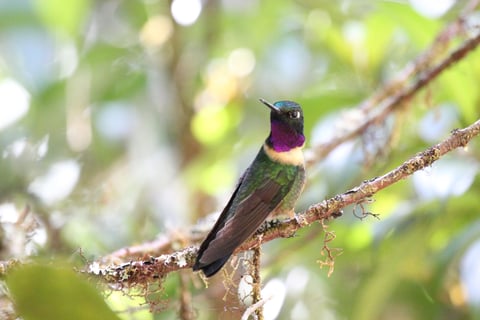Dutch birders discover rare hummingbird species at Huitepec
A group of young Dutch travellers to San Cristobal de Las Casas encountered the Amethyst-throated Mountain Gem at the Huitepec Ecological Reserve on our daily group tour
At the start of February, I took three Dutch travelers on a birdwatching tour to the Huitepec Ecological Reserve, a three-pronged volcano which overlooks San Cristobal de las Casas in Chiapas, Mexico. This unique cloud forest ecosystem, home to a remarkable diversity of bird species, has a lush and crisp mountain air that immediately revitialises me every time I step into the reserve.
I was particularly excited on this trip to introduce my quick-reference guide to the birds of San Cristobal, which proved to be a huge hit with our Dutch gang.
About the Huitepec Ecological Reserve
The Huitepec Ecological Reserve is a protected area encompassing approximately 135 hectares on the Huitepec volcano. It was established in 1986 through a conservation trust and later designated as an ecological reserve by the civil association Pronatura, in response to concerns from local residents about preserving the remaining cloud forest and oak groves. Additionally, a community reserve of 102 hectares was declared by the Zapatista bases of Huitepec Ocotal in 2005, further expanding the protected area.
Cloud forests, like the one in Huitepec, are characterized by persistent fog and high humidity, creating a microclimate that supports a rich variety of flora and fauna. These ecosystems are fragile due to their topography and biological characteristics, making conservation efforts crucial. The reserve protects a significant remnant of this endangered habitat, which covers less than 1% of Mexico's surface and has been heavily impacted by human activities such as agriculture, logging, and urban expansion. The Huitepec Ecological Reserve stands as a testament to the power of community-driven conservation. Its misty slopes and dense vegetation provide a sanctuary for countless species, many of which are found nowhere else on Earth.
Why It's Great for Birdwatching
The Huitepec Ecological Reserve is a paradise for birdwatchers due to its high biodiversity and the presence of many rare and endemic species, including the Garnet-throated Hummingbird, the Rufous-collared Robin, the Amethyst-throated Mountain Gem, and even the Grey-breasted Wood Wren. The reserve's varied elevations and microclimates create a mosaic of habitats, each supporting different bird communities. From the canopy-dwelling trogons to the understory-skulking wrens, there's always something new to discover.
The Birdwatching Experience
This time we had a group of three nature enthusiasts travelling from the Netherlands to San Cristobal, Maja and her partner, and their best friend Jan. Although they had all used binoculars before, their experiences had mostly been using the big clunky ones their parents lugged around on family holidays, and it was certainly their first time using them for birding. We set out early in the morning to and arrived at the misty trailhead.
Birds of the Day
Among the many species observed, several stood out for their beauty and uniqueness:
The Rivoli's Hummingbird (Eugenes fulgens), with its iridescent plumage, was a dazzling sight as it flitted among the flowers.
The Mountain Trogon (Trogon mexicanus), initially heard calling in the distance, added a touch of mystery to the forest with its resonant voice. Later, it revealed itself perched majestically on a branch, much to the delight of the group.
The Blue-and-white Mockingbird (Melanotis hypoleucus) impressed with its striking coloration and melodic songs.
A flock of Gray Silky-flycatchers (Ptiliogonys cinereus) perched high in the trees, their elegant silhouettes contrasting against the sky.
The Rufous-collared Robin (Turdus rufitorques), a familiar yet distinctive species, was spotted foraging on the forest floor.
The Golden-browed Warbler (Basileuterus belli) and the Slate-throated Redstart (Myioborus miniatus) added splashes of color to the greenery with their vibrant feathers.
One of the trip's highlights was a close encounter with a Amethyst-throated Mountain Gem (Lampornis amethystinus), its throat gleaming like a precious stone in the dappled sunlight. These sightings, among others, made the trip an unforgettable experience for us all.


Photo credit: Dominic Sherony
